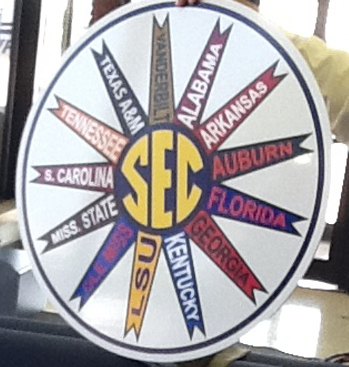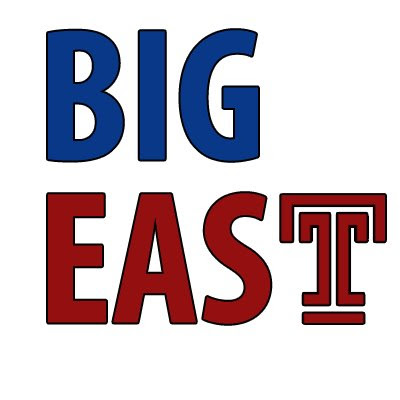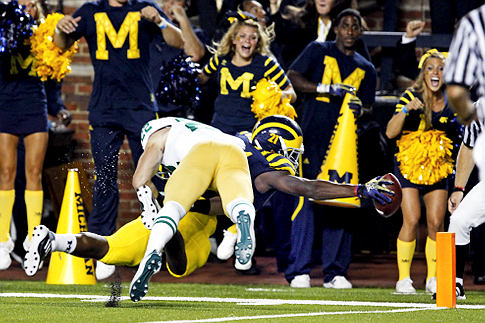 Buckeye Archive
Buckeye Archive  The Season That Will Be: Odds 'n Ends
The Season That Will Be: Odds 'n Ends
 The college football season begins in just a few weeks with a full slate of games of Labor Day weekend. It’s a weekend to be looked forward to with more than a little bit of ambiguity.
The college football season begins in just a few weeks with a full slate of games of Labor Day weekend. It’s a weekend to be looked forward to with more than a little bit of ambiguity.
That ambiguity comes in the wake of All-American defensive back Tyrann Mathieu’s dismissal from the LSU team for “violation of team policies,” meaning repeated failure of drug tests. I don’t know Tyrann Mathieu and I have no inherent problem with recreational drug use, but I have to ask: if not for football, would this kid be anywhere near a college campus?
There is no other sport as transparently corrupt as college football, and the most striking thing is how shamelessly corrupt it is at every level- the bowl system, the coaching fraternity, the players; every aspect. Corruption in this sport is expected and accepted. Everyone knows coaches cheat. Everyone knows that the term “scholar-athlete” is a sham.
The corruption is endemic, because the concept of big-time college football is inherently contradictory. It’s basically a semi-pro sports system run by institutions that really have no business being in that business to begin with. Because of this contradiction, the business of big-time college football is a business that dare not speak its name. If it isn’t supposed to be a business but is, that makes it a racket. That’s what big-time college football is. It has all of the purity of the porn industry, and none of the honesty.
So why the ambiguity? Because it’s a great game to watch. That’s the reason. It isn’t a very profound reason, but there it is. And best believe that when it begins again on the field in a few weeks, I will make my own compromise and watch the living crap out of it like I always do. Let’s do it.
Conference Confusion
It’s getting to the point where you can’t tell the conferences without a scorecard. 2012 is only another phase in a game of musical chairs which shows no signs of ending soon, as schools big and small pick up stakes and move on to what they hope will be greener pastures.
All of this movement can get a little bit confusing. So, in the interests of clarity, I’ve charted the comings and goings of every shift in each of the FBS conferences. Of course, this chart won’t be current for long- the changes will continue into next year and beyond.
Southeastern Conference
Joined: Missouri, Texas A&M
Departed: None. Are you kidding me? This is God’s Conference, who would want to leave?
God’s Conference is up to fourteen teams, thanks to its poaching of two Big 12 schools. Texas A&M’s reason for defecting was similar to Nebraska’s last year- resentment and fear of the University of Texas’s domination of the conference. Missouri just wanted to make sure it didn’t get caught out in the cold in case the Big 12 imploded entirely.
I’m not sure how big of a coup this really was, though. Obviously getting a foothold in the vast Texas market is a good thing, but A&M hasn’t been nationally relevant for well over a decade. Missouri has a respectable football tradition but probably won’t be among the SEC elite.
Still, it’s too bad the Big Ten was unwilling to bring in Missouri last year. The former is simply a superb fit both from a geographic and, with its solid basketball pedigree, an athletic standpoint. Missouri would have fit the Big Ten better than any other school the conference could have brought in, including Nebraska. Oh well.
Big 12 Conference
Joined: West Virginia, TCU
Departed: Missouri, Texas A&M
Surprisingly for a conference that looked to be on the verge of extinction at this time last year, the Big 12 continues to live, breathe- and expand. TCU is a natural fit, a school with deep roots in the old Southwest Conference and long-standing rivalries with Texas, Baylor and Texas Tech. West Virginia is not so much, with Morgantown being a 15-hour drive from its closest Big 12 rival. Competitively and aesthetically, however, the Mountaineers fit like a glove- Dana Holgorsen is a former assistant coach in the Big 12 and his team’s frenetic passing offense will look very familiar in the far Midwest.
Big East Conference
Joined: Temple
Departed: West Virginia
 In 2004 the Big East, tired of dragging the carcass of Temple football and preparing to expand, voted to boot the Owl program out of the conference. After two years as an independent Temple moved to the MAC and prospered. In the last three years the Owls have gone 26-12 and played in three bowl games, including a rout of Wyoming in last season’s New Mexico Bowl.
In 2004 the Big East, tired of dragging the carcass of Temple football and preparing to expand, voted to boot the Owl program out of the conference. After two years as an independent Temple moved to the MAC and prospered. In the last three years the Owls have gone 26-12 and played in three bowl games, including a rout of Wyoming in last season’s New Mexico Bowl.
By 2012, with West Virginia gone and Pitt and Syracuse all set to follow the Mountaineers out the door, all of a sudden Temple football doesn’t look all that homely to a conference struggling to maintain at least a shred of viability. At least Temple is in, you know, the East, unlike future members SMU, Boise State and San Diego State. And even allowing for the less-competitive environs of the MAC, it’s clear that the Owls have turned over a new leaf on the football field.
By the way, here’s how the Big East will look in 2015:
Connecticut
Rutgers
Temple
Villanova (maybe)
Navy
South Florida
Central Florida
Cincinnati
Louisville
Memphis
Houston
SMU
Boise State
San Diego State
Yup, looks pretty “Eastern” to me, too.
Mountain West Conference
Joined: Nevada, Hawaii, Fresno State
Departed: TCU
Not long ago the MWC, with its power troika of TCU, Utah and BYU, was arguably worthy of BCS status. Now the conference, buffeted by the past and current departures of all three of those schools as well as the 2013 defections of Boise State and San Diego State, is fighting for survival.
Its survival strategy consists of poaching the Western Athletic Conference. Last year the MWC stole Boise State; this year it adds Nevada, Hawaii and Fresno; next year it takes Utah State and San Jose State. By 2014 the league will consist of those five teams as well as holdovers Air Force, Colorado State, New Mexico, UNLV and Wyoming. Unlike the WAC, the Mountain West will survive- but its days of competing for BCS at-large spots or getting into the automatic-bid conversation are likely over for the time being.
Western Athletic Conference
Joined: Texas State UT-San Antonio
Departed: Nevada, Hawaii, Fresno State
No one has gotten a worse end in the game of conference musical chairs than the WAC, which has already been shorn of its elite members and will shrink even further in 2013 when six more affiliates flee for greener pastures- including newbies Texas State and UT-San Antonio, which will flee for the Sun Belt and Conference USA after one year of WAC play. By 2014 the football side of the WAC will consist of Idaho and New Mexico State. That’s it. Needless to say, you can’t compete as a two-team league, never minding that your two teams are among the weakest in the FBS.
So what to do? Idaho should re-apply to the Big Sky and drop back down to the FCS level. The Vandals play in the smallest stadium in the FBS and have struggled mightily, posting just one winning season since the turn of the century. New Mexico State has competed at the highest level of college football for more than a half-century, but maybe the Aggies should also drop down a level considering their miserable competitive history (no bowl bids in the last 52 years.)
It’s kind of a sad denouement if, like me, you remember when WAC football, with its record-shattering aerial shows, was must-see TV. One of the five best games I ever watched was the 52-52 tie between Ty Detmer’s BYU and Marshall Faulk’s San Diego State back in 1991. Those days are long gone- as is this conference and its fifty-year history.
Mid-American Conference
Joined: Massachusetts
Departed: Temple
The MAC’s reward for helping to succor Temple football back to life was being dumped by the Owls for their former conference at the first opportunity. Undaunted, the conference has reached even further cast for its newest member. UMass was a longtime power at the Division I-AA level, winning the National Championship in 1998, and although the Minutemen have leveled off since then, they still had the potency to scare Michigan at the Big House two years ago. I’m not sure why the MAC needs 13 teams for football, unless the league is looking to expand westward at some point as well.
Five Non-Conference Games to Watch
Friday, August 31- Boise State @ Michigan State: This game might have been more fun had it been played last season, when the Broncos and Spartans had veteran

lineups led by decorated senior quarterbacks. Still, both teams ought to be formidable again, and it’ll be interesting to see how Boise fares in a true road game against a Big Ten opponent. The Broncos have played only one game against the Big Ten in their history, a 28-24 loss at Wisconsin back in 1997.
Saturday, September 1- Alabama vs. Michigan (Cowboys Stadium): Pre-bowl meetings between Big Ten and SEC powers are as rare as hens teeth, so this matchup between the defending BCS Champion Tide and the rejuvenated Wolverines should be a treat; though not so much for Denard Robinson as he attempts to avoid being physically killed by Nick Saban’s defense. Survival is the watchword for Michigan, which doesn’t have to beat Alabama; just play well and compete.
Saturday, September 1- Auburn vs. Clemson (Georgia Dome): The defending ACC Champion Tigers had reason to feel optimistic about the neutral-site lid-lifter, what with the bulk of their offense back to face an Auburn team that finished 80th in the nation in total defense last season. That was before the drug-related suspension of ACC preseason player of the year Sammy Watkins. Auburn is attempting to bounce back from its lackluster showing in 2011, when it went 8-5 and was outscored. One of the losses was to Clemson, which snapped the SEC Tigers’ 17-game winning streak in week three.
Saturday, September 8- Washington @ LSU: Steve Sarkasian’s Huskies played LSU tough up in Seattle three years ago and are a better team in 2012 with star quarterback Keith Price, a veteran offensive line, and a defense that returns the bulk of its starters (maybe not a good thing considering U-Dub finished 106th in the nation in total defense and gave up 67 points in the Alamo Bowl.) A night game in Death Valley against the Tigers will be a hell of an acid test for Sarkasian’s team.
Saturday, September 22- Michigan @ Notre Dame: Over the last three seasons there hasn’t been a better series in college football than the one between the Wolverines and Irish. The last three have been decided by four points apiece, the winning scores coming with 11, 27 and 2 seconds to play. All have been won by Michigan. Brian Kelly has beaten USC and won a bowl game- but he hasn’t beaten the Wolverines, and he has the game in South Bend this season. Count on another thriller between these two evenly matched teams.
Five Coaches on the Hot Seat
Actually the hot seat is a little less populated these days, with perennial denizens such as Rick Neuheisel, Dennis Erickson, Mike Sherman and Mike Locksley getting 86’d during or after last season. With so many first-year coaches- 28 schools have new men at the top- the firing line looks a bit shorter. This is the coaching profession, though, and as Bum Phillips says, there’s only two kinds of coaches- them that’s been fired, and them that’s gonna be fired.
Derek Dooley, Tennessee: Dooley was kind of a curious hire to begin with (he was 17-20 in three years at Louisiana Tech) and whatever honeymoon he enjoyed in Knoxville is long gone after two seasons and an 11-14 record. Conference play is a true measure of a coach’s worth, and thus far Dooley’s Volunteers are a pitiful 4-12 in the SEC, including 1-7 last year. It really shouldn’t take that long to get things turned around at a place like Tennessee, and Vince’s kid is running out of time.
Mike Riley, Oregon State: Riley has long been one of the best under-the-radar coaches in America, but there’s a sense now that his act has grown a bit stale in Corvallis. The Beavers are 8-16 in the last two years, including a woeful 3-9 mark in 2011, and have fallen far behind arch-rival Oregon in the Pac-12 pecking order.
Randy Edsell, Maryland: After a highly successful tenure at UConn, Edsall was supposed to take the Terps to the next level. Instead they suffered through a 2-10 disaster punctuated by the regression and transfer of highly touted quarterback Danny O’Brien. Edsall is only in his second season in College Park, but he can’t afford another season like the last one.
Brian Kelly, Notre Dame: Barring a complete collapse, Kelly’s job is safe for the foreseeable future. Still, his 16-10 record in two years has to be considered a disappointment, especially since so many of the losses should have been wins if not for Irish mistakes. The common themes of Kelly’s tenure so far have been slow starts (1-3 in 2010, 0-2 in 2012), close losses (5-6 in games decided by a touchdown or less) and turnovers at the absolute worst time. Those themes need to start changing for a coach that was expected to bring the Irish out of their twenty-year doldrums.
Doug Marrone, Syracuse: The Orange were 5-2 last season after routing West Virginia but finished with five straight losses. While Marrone does have a bowl win on his Syracuse resume he’s also 17-20 overall, including a stunning 1-10 at home in conference play. Another lackluster season both on the road and in the Carrier Dome might endanger Marrone’s chances of leading his alma mater into the Atlantic Coast Conference.
*****
I’ll be back next week with predictions and prognostications for the upcoming season. Until then…
- NBA Announces 2013-2014 Schedule
- Browns Ink Sharknado
- Sharknado A No-Show For Rookie Camp
- Trent Richardson Out Until Training Camp
- Browns Sign Brandon Jackson
- Carrasco Suspended Eight Games
- Browns Add to Wide Receiver Depth with David Nelson
- Browns Need to Learn from Past Draft Mistakes
- Browns Release Chris Gocong and Usama Young
- Browns Missing on Grimes Disappointing, But Not The End
The TCF Forums
- Official- Browns Coach Search/Rumors
Hikohadon (Tuesday, January 21 2014 1:24 PM) - Movies coming out
rebelwithoutaclue (Tuesday, January 21 2014 12:56 PM) - 2015 Recruiting
jclvd_23 (Tuesday, January 21 2014 12:38 PM) - The 2014 Offseason Thread
Larvell Blanks (Tuesday, January 21 2014 12:25 PM) - Chris Grant's first 3 drafts
Kingpin74 (Tuesday, January 21 2014 10:13 AM) - Mike Brown
YahooFanChicago (Monday, January 20 2014 11:15 PM) - 2014 Hoops Hockey Hijinx
jpd1224 (Monday, January 20 2014 4:44 PM) - 2014 Recruiting
jclvd_23 (Monday, January 20 2014 2:26 PM) - Wish List - #4 Pick
Hikohadon (Monday, January 20 2014 1:26 PM) - #1 overall pick Anthony Bennett
TouchEmAllTime (Sunday, January 19 2014 1:28 PM)



